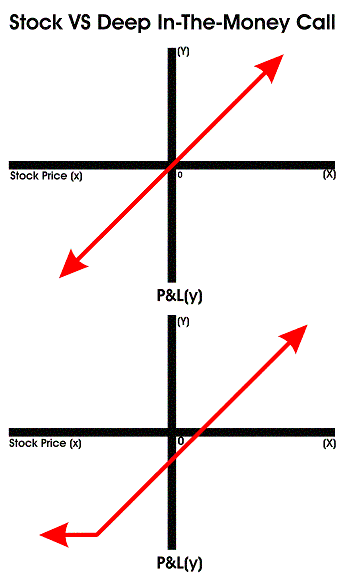
Trading Puts & Call OptionsProvided By Options University What Is The Best Way To Trade Call Options?
Call options are a derivative trading product that is best used
by investors as a hedging tool providing profit protection and
profit enhancement. Although it is a powerful risk management
tool, it can also be used effectively as a stand-alone trading
vehicle.
For chart below, stock price = $35.00
Under the proper conditions, call options do not have to be paired with stock or other call options to be an effective trading tool. To successfully trade naked options, an investor must realize that certain call options will fit certain scenarios and certain call options will not. One of the major misconceptions that investors have about options stems from the fact that most do not know how to trade call options properly. When they lose money trading them, they feel that there is something wrong with their call options. They do not understand that call options are on a higher, more sophisticated level when compared to stocks. Stock trading has fewer variables involved and is therefore easier. No one is saying that the individual investor isnt smart enough to trade call options. The problem is not intelligence; its just education and experience. Most investors have not been properly educated in the proper use of call options, and even fewer have had any real experience trading them. One of the biggest problems investors have is this: Even if you buy a call and the stock goes up, you can still lose money. Most investors tend to buy out of the money options at a cheap price. The stock trades up a little, which is the right direction, but the call options still lose money and the investor wonders why. What the investor fails to realize is that in order for the call options to be profitable the options delta must out-pace its rate of decay. Implied volatility also plays a key role if the stock does trade up while implied volatility decreases, the options delta must then outperform the decrease in volatility. Remember, when volatility increases, the price of all call options goes up. When volatility decreases, the price of all call options goes down. We have categorized call options in several ways. One way is by the options strike price, and its distance from the stock price. We identified these call options as either in-the-money, at-the-money, or out-of-the-money. In our discussion about trading naked calls and puts, we will identify trading opportunities or situations that fit each of these types of options, for both call options and puts. But it is important to first review the definition of Delta before continuing. Remember, delta tells you how much the call options will move with a similar move in the stock and is given as a percentage. For example, a 33 delta option means that the call options will move 33% of the movement of the stock and 70 delta option will move 70%. In-the-money options act like stock. The deeper in the money the call options are, the more they act like the stock. As the call options move deeper and deeper in the money, the calls delta approaches 100 which means its price movement will reflect 100% of the stocks movement. In fact, deep-in-the-money options are sometimes even used to replace stock positions. If you look at the charts below, you can see how closely the in-the-money call mimics the upward movement of the stock (2nd quadrant).  As you wait for your stock movement, the in-the-money option will decay less than either the at-the-money or out-of-the-money options because it has less extrinsic value. The amount of money you lose in time decay must then be made back by additional stock movement. Obviously, the less you lose in decay, the less the stock has to move for you to be profitable because it has less decay loss to make up for. This is because an in-the-money call has a high delta and a much higher percentage chance of finishing in-the-money by expiration so they follow the stock more closely. With less extrinsic value loss to make up for, a smaller movement in the stock will produce a greater profit. For a call example, as you can see in the chart below, the in-the-money produces a profit with the least amount of stock movement. With less extrinsic value, the ITM option has a lower break-even point.
Discover these secret option trading strategies that will have your friends calling YOU 'the options expert' Click here!
copyright 2005 Call Options
|